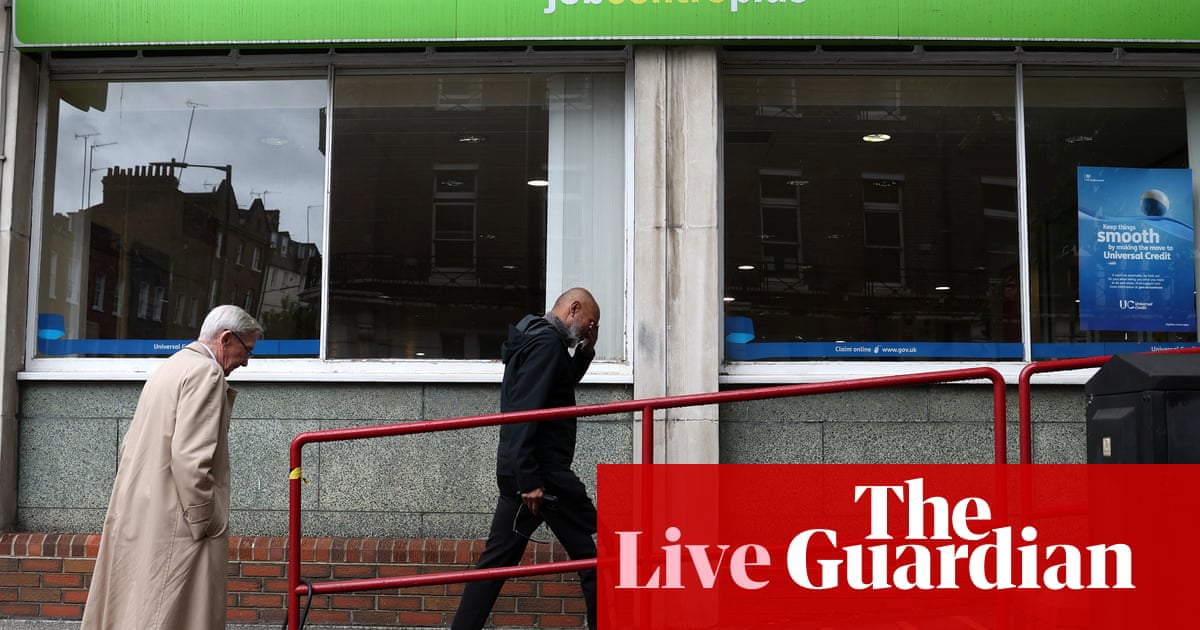Good morning, and welcome to our rolling coverage of business, the financial markets and the world economy.
Wage growth across the UK has slowed, and the number of people on payrolls has fallen, as Britain’s jobs market continues to cool.
The latest UK labour market data, just released, shows that average regular earnings (excluding bonuses) rose by 5.6% in January to March 2025, down from 5.9% in the previous quarter.
Growth in pay including bonuses also slowed – it rose by 5.5% in January-March, down from 5.7% in the final three months of 2024.
Although wages growth slowed, earnings are still rising faster than prices in the shops. Once you adjust for inflation, pay (both regular and total) rose by 2.6% per year on both measures.
Minister for Employment,Alison McGovernhas said:
But, today’s report also shows a drop in demand for workers, as UK companies adjust to the increase in the minimum wage, and higher national insurance contributions, which kicked in at the start of April.
TheOfficeforNationalStatisticsreports that the number of payrolled employees felled by 33,000 in April, following a 47,000 drop in March.
On an annual basis, there were 106,000 fewer payrolled employees in April than a year ago, the ONS estimates.
In another sign that firms are being cautious, the number of vacancies in the UK fell by 42,000 in the January-March quarter, the 34th consecutive quarterly decline in a row. The biggest fall came in the construction sector
ONSdirector of economic statisticsLiz McKeownsays:
7am BST: UK labour market report
10am BST: ZEW survey of eurozone economic confidence
10am BST: Environment, Food and Rural Affairs Committee (EFRA) to quiz the CEO, CFO and Chair of Thames Water
1.30pm BST: US inflation report for April
The increased cost of hiring workers in the UK is continuing to dampen the job market, according to the Institute of Directors.
Alex Hall-Chen, Principal Policy Advisor for Employment at theInstituteofDirectors, says:
Economists are concerned that the UK’s jobs market appears to have cooled in recent months, judging bytoday’s labour statistics.
Suren Thiru,ICAEWeconomics director, fears the employment market is cooling, saying:
Paige Tao, economist atPwC UK,suggests the weakening jobs market could spur the Bank of England towards further interest rate cuts:
Lindsay James, investment strategist atQuilter, fear today’s jobs report may be “the start of the expected slowdown”, adding:
The UK’s unemployment rate has risen to its highest in almost four years, today’s labour market data shows.
At 4.5% in January-March, the jobless rate for those aged 16 and over was the highest since June-August 2021, when it was also recorded at 4.5%.
Nicholas Hyett, investment manager atWealth Club,says:
Here are more key facts from this morning’s jobs report:
The UK employment rate for people aged 16 to 64 years was estimated at 75.0% in January to March 2025. This is above estimates of a year ago, but largely unchanged in the latest quarter.
The UK unemployment rate for people aged 16 years and over was estimated at 4.5% in January to March 2025. This is above estimates of a year ago, and up in the latest quarter.
The UK economic inactivity rate for people aged 16 to 64 years was estimated at 21.4% in January to March 2025. This is below estimates of a year ago, and down in the latest quarter.
Good morning, and welcome to our rolling coverage of business, the financial markets and the world economy.
Wage growth across the UK has slowed, and the number of people on payrolls has fallen, as Britain’s jobs market continues to cool.
The latest UK labour market data, just released, shows that average regular earnings (excluding bonuses) rose by 5.6% in January to March 2025, down from 5.9% in the previous quarter.
Growth in pay including bonuses also slowed – it rose by 5.5% in January-March, down from 5.7% in the final three months of 2024.
Although wages growth slowed, earnings are still rising faster than prices in the shops. Once you adjust for inflation, pay (both regular and total) rose by 2.6% per year on both measures.
Minister for Employment,Alison McGovernhas said:
But, today’s report also shows a drop in demand for workers, as UK companies adjust to the increase in the minimum wage, and higher national insurance contributions, which kicked in at the start of April.
TheOfficeforNationalStatisticsreports that the number of payrolled employees felled by 33,000 in April, following a 47,000 drop in March.
On an annual basis, there were 106,000 fewer payrolled employees in April than a year ago, the ONS estimates.
In another sign that firms are being cautious, the number of vacancies in the UK fell by 42,000 in the January-March quarter, the 34th consecutive quarterly decline in a row. The biggest fall came in the construction sector
ONSdirector of economic statisticsLiz McKeownsays:
7am BST: UK labour market report
10am BST: ZEW survey of eurozone economic confidence
10am BST: Environment, Food and Rural Affairs Committee (EFRA) to quiz the CEO, CFO and Chair of Thames Water
1.30pm BST: US inflation report for April
